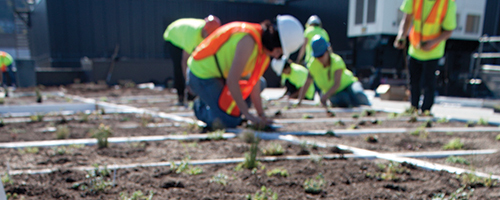Americans have had a presence in space since 1961, when Alan Shepard first crawled into a tiny metal capsule and left Earth. Since then, the U.S. government has been responsible for taking each and every astronaut there.
Professor takes one small step
Americans have had a presence in space since 1961, when Alan Shepard first crawled into a tiny metal capsule and left Earth. Since then, the U.S. government has been responsible for taking each and every astronaut there.

Miles Sanguinetti/VANGUARD STAFF
CAMERON SMITH, a PSU anthropology professor, works on space suit he’s building.
Cameron Smith wants to change that.
For the past three years, Smith, a professor of anthropology at Portland State University, has been building a pressure suit he plans to take up to 50,000 feet to what NASA calls “space equivalent conditions.”
In addition to the suit, Smith is in the beginning stages of a plan to build an open-air balloon that will carry him into the lower stratosphere.
While some may find this work strange coming from an anthropologist, Smith simply sees it as the next step in hominid evolution.
“We take a lot of control over our own evolution, and one of the ways is by manipulating objects,” Smith said. “Whether it is by a pressure suit in the stratosphere, or somebody sawing antlers into pieces and using it as a puncturing tool 20,000 years ago, it is the same thing.”
Smith began work on his pressure suit in 2009 using parts he purchased on eBay, including a 1984 Soviet flight helmet that cost $350.
Although he has lost track of the total cost of the project to date (he has a “bucket of receipts” somewhere), he estimates he has spent less than the cost of a used car.
With the suit nearing completion, Smith is facing the next hurdle. It shadows the entire future of space exploration: the logistics of the testing and deployment into space in an industry fractured by budgetary constraints.
Smith also is battling a fear of public disappointment.

Miles sanguetti/VANGUARD STAFF
CAMERON SMITH models his homemade space suit. The PSU anthropology professor spent his own money to buld it.
“I’ve met a lot of NASA who are demoralized at the state of NASA. It has become fossilized; a ‘can’t do’ rather than a ‘can do’ operation,” Smith explained.
Because the technology for exploration has leaked into the private sector, Smith sees this moment as a “Wright Brothers era.” It’s only a matter of time until someone delivers cheap access to space, he explained.
Pat Hanrahan, planetarium director at Mt. Hood Community College, worries more about the state of NASA and the government’s involvement in space exploration, and sees the private sector’s recent interest as a fad:We as a culture need to value science and space exploration, and the government needs more money to be involved.”
Hanrahan points to the cell phone, explaining that its parts were only abstract science mere decades ago. Through principles tested by NASA it evolved into the technology it is today.
The impasse is unlikely to resolve itself soon, but Smith continues to build his suit and test for his upcoming voyage.
Unlike Paul Allen or Richard Branson, two famously wealthy investors funneling large amounts of time and money into space tourism, Smith’s personal interest seems tempered with his scientific credentials.
“For 200 years, European explorers described the Antarctic as a wasteland. But then we go there, and it’s not just a void,” Smith said. “There is a complex there, and I think the stratosphere is the same thing.”
The peak of Mount Everest is roughly 30,000 feet above sea level, and commercial airlines barely reach 40,000. While military planes can reach 50,000, Smith explained that they have different priorities; they are not looking at the atmosphere. The enviroment is extremely cold and, according to Hanrahan, slightly darker than what lies below.
This radically different environment poses interesting scientific possibilities to Smith, who said that emerging research in microbes within the stratosphere is to radically change existing scientific paradigms.
Ignoring budget debates and the private versus public argument, Smith practices what he views as
participating in human evolution by taking the first steps himself.





